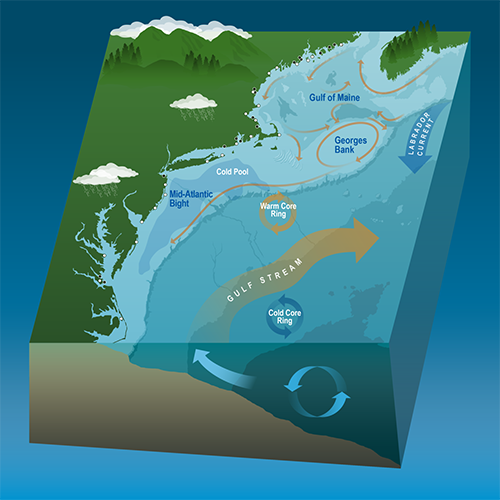Georges Bank is a relatively shallow (3-150 m) submarine plateau off the coast of New England in the Atlantic Ocean, forming an area larger than the state of Massachusetts (Link et al. 2005).
Due to its shallow and well-mixed waters, Georges Bank is unique in its capacity for high primary productivity as an offshore region with concentrations of chlorophyll a on the Bank reflective of those found in near-shore regions of the continental shelf (NEFSC; Fogarty et al. 1998). This high primary productivity supports an extensive food web including high levels of fish production that have sustained commercial fisheries since the 16th century. Flagship commercial species in this region include Atlantic cod (Gadus morhua), haddock (Melanogrammus aeglefinnus), and sea scallop (Placopectin magellanicus) among many others. In addition, the southeastern portion of Georges Bank forms an important feeding ground for North Atlantic Right whales and other marine mammals. Marine turtles such as the loggerhead (Caretta caretta), Kemp’s ridley (Lepidochelys kempii), and leatherback (Dermochelys coriacea) are also seen frequently in the region (GOMC 2018).

References:
- Link, Jason, et al. "The Effects of Area Closures on Georges Bank." American Fisheries Society Symposium. Vol. 41. 2005.
- Dyke, Arthur, and Victor Prest. "Late Wisconsinan and Holocene history of the Laurentide ice sheet." Géographie physique et Quaternaire 41.2 (1987): 237-263.
- https://pubs.usgs.gov/fs/georges-bank/
- https://www.nefsc.noaa.gov/ecosys/ecosystem-ecology/phytoplankton.html
- Fogarty, Michael J., and Steven A. Murawski. "LARGE‐SCALE DISTURBANCE AND THE STRUCTURE OF MARINE SYSTEMS: FISHERY IMPACTS ON GEORGES BANK." Ecological Applications 8.sp1 (1998).
- Gulf of Maine Council on the Marine Environment (GOMC). State of the Gulf of Maine Report. 2010. http://www.gulfofmaine.org/state-of-the-gulf/docs/the-gulf-of-maine-in-context.pdf
